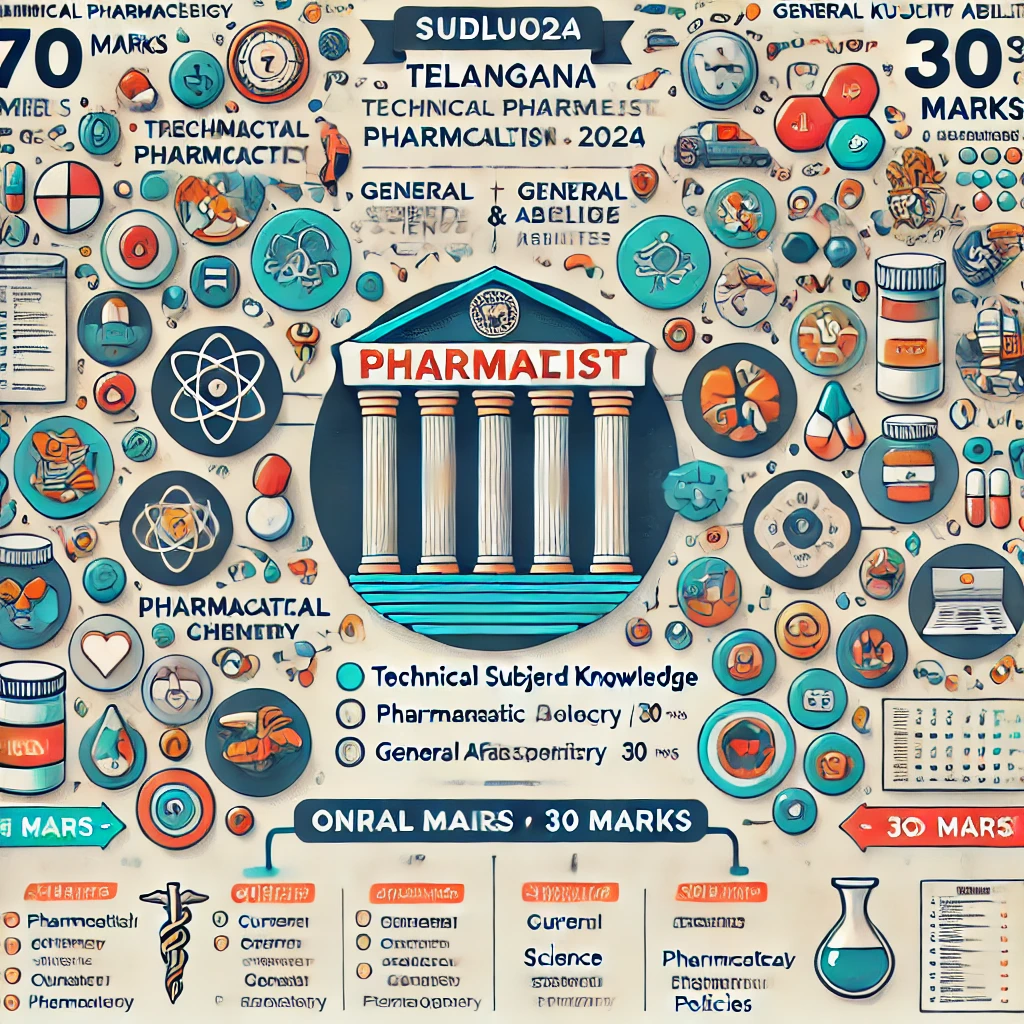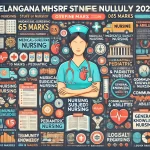Medical & Health Services Recruitment Board (MHSRB) of Telangana State has released an official notification for the recruitment on 633 posts of pharmacists in 2024. Candidates aspiring to secure a government job as a pharmacist (Grade-II) are keen to understand the MHSRB Pharmacist syllabus and exam pattern, which are critical for exam preparation.
This article provides a detailed information of Telangana MHSRB Pharmacist Syllabus 2024, including the online exam pattern along with subjects and topics covered.

Contents
Telangana MHSRB Pharmacist Exam 2024
The Telangana MHSRB Pharmacist recruitment exam is held to fill the vacancies of pharmacists in government medical institutions across Telangana state. The selection process consists of an online written exam followed by document verification. Candidates must prepare well to score well in the exam and secure their position as a pharmacist in state’s government hospital.
| Conducted By | Telangana State Medical & Health Services Recruitment Board (MHSRB) |
| Name of Post | Pharmacist (Grade-II) (General Recruitment) |
| No of Vacancies | 633 Posts |
| Category | Syllabus & Pattern |
| Notification No. | 05/2024, DATED: 24.9.2024 |
| Salary | Rs 31,040 – 92,050. |
| CBT Exam Date | 30 November 2024 |
| Selection Process | Written Test & Document Verification |
| Exam Type | Computer Based Test (MCQ-CBT) |
| Official Website | mhsrb.telangana.gov.in/MHSRB/home.htm |
Telangana Pharmacist Exam Pattern 2024
Below is the outline of the exam pattern:
- Mode of Exam: Online (Computer-Based Test)
- Type of Questions: Multiple Choice Questions (MCQs)
- Total Questions: 80 questions
- Duration: 90 minutes
- Total Marks: 80 marks
- Negative Marking: No Negative marking.
- Language of the Exam: English Only
- Merit Weightage: 80% Online written test and 20% Experience.
| Subject | Questions/Points | Max Marks/Points |
| Pharmacy Subjects (Diploma Level) | 80 | 80 |
| Work Experience (state government hospitals/ institutions/ programmes on contract/outsourced basis) | 20 | 20 |
| TOTAL | 100 | 100 |
Telangana MHSRB Pharmacist Syllabus 2024
Unit- I
- Introduction to Pharmacopoeias with special reference to the IP.
- Packaging of pharmaceuticals (Containers and Closures) – Glass, Plastics and
Rubber. Introduction to aerosol packaging. - Unit Operations: Size reduction, Size separation, Mixing & Homogenisation, Evaporation, Distillation, Drying, Filtration, Extraction and Sterilization.
- Prescription- Prescriptions, Latin terms and Incompatibilities in prescriptions (Physical, Chemical and Therapeutic).
- Metrology & Posology- Calculations of doses on the basis of age, sex, surface area. Percentage calculations, Proof spirit, Allegation method, Isotonic solutions and Displacement value.
- Manufacturing and evaluation various dosage forms: Tablets, Capsules, Suppositories, Emulsions, Suspensions, Lotions, Ointment, Cream and Pastes. Parenteral and Ophthalmic products.
- Study of Immunity & Immunological products like sera, vaccines, toxoids & their preparations.
Unit- II: Anatomy and Physiology of – Skeletal System, Cardiovascular System, Haemopoietic
system, Respiratory system, Urinary System, Muscular System, Central Nervous System, Automatic Nervous System, Sensory Organs, Digestive System, Endocrine System and Reproductive system.
Unit-III
- Concept of health, Concept of disease, Natural history of diseases, the disease agents and Concept of prevention of diseases.
- Nutrition and health: Classification of foods, requirements, diseases induced due to deficiency of proteins, vitamins and minerals-treatment and prevention.
- Demography and family planning: Demography cycle, fertility, family planning methods.
- First aid: Emergency treatment in shock, snake-bite, burns, heart disease, fractures and resuscitation methods, Elements of minor surgery and dressings.
- Fundamental principles of microbiology: Microbes, isolation & staining techniques.
- Communicable diseases: Causative agents, mode of transmission and prevention of chicken pox, measles, influenza, diphtheria, whooping cough, tuberculosis, poliomyelitis, Hepatitis, cholera, Typhoid, food poisoning, Hookworm infection, plague, Malaria, filariasis, Rabies, Trachoma, Tetanus, Leprosy, Syphilis, Gonorrhoea, AIDS.
Unit- IV
- Medicinal and Pharmaceutical uses of following class of Inorganic Compounds:
Acidifying agents, Antacids, Protective and Adsorbents, Antimicrobials, Astringents, Dental Products, Respiratory stimulants, Expectorants & Emetics, Antidotes, Electrolytes - Inorganic official compounds of Iron, Iodine, Calcium, Ferrous Sulphate and Calcium Gluconate.
- Radio pharmaceuticals and contrast media- Radio activity, Radio isotopes and Radio opaque contrast media (Barium sulfate).
- Limit tests for Arsenic, Chloride, Sulfate, Iron and Heavy metals.
- The chemistry of following class of Pharmaceutical Organic Compounds- Antiseptics and Disinfectants, Sulphonamides, Antileprotic Drugs, Anti-tubercular Drugs, Anti- amoebic & Anthelmintic Drugs, Antibiotics, Antifungal agents, Antimalarials, Tranquilizers, Hypnotics & sedatives, General Anaesthetics, Antidepressants, Analeptics, Adrenergics, Adrenergic antagonist, Cholinergics, Cholinergic Antagonists, Diuretics, Cardiovascular Drugs, Hypoglycemic Agents, Coagulants and Anti coagulants, Local Anaesthetics, Histamine and anti-Histaminic Agents, Analgesics and Anti-pyretics, NSAIDS, Thyroxine and Anti-thyroids, Anticonvulsants, Cardiac glycosides, Antiarrhythmic, Antihypertensives, Vitamins,
Steroids, & Anti-Neoplastic Drugs.
Unit- V
- Sources of drugs, Routes of administration of drugs, Various processes of absorption, metabolism, distribution and excretion of drugs. General mechanism of drug action and drug interactions.
- Pharmacology of following class of drugs: General anaesthetics, Analgesics, antipyretics and NSAIDS, Narcotic analgesics, Antirheumatic, Sedatives & Hypnotics, antipsychotics, anticonvulsants, analeptics, Muscle relaxants, anti-parkinsonism agents, Local anesthetics, Cholinergic drugs, Anticholinergic drugs, Adrenergic drugs and Adrenergic antagonists, Mydriatics, Respiratory stimulants, Bronchodilators, Nasal decongestants, Expectorants and Antitussive agents, Autocoids, Cardiotonics, Antiarrhythmic agents, Anti-anginal agents, Antihypertensive agents, peripheral Vasodilators.
Unit- VI
- Pharmacology of following class of drugs: Haematinics, coagulants and anticoagulants, Haemostatics, Blood substitutes and plasma expanders, Diuretics and anti-diuretics, Hypoglycemic agents, Antithyroid drugs, sex hormones and oral contraceptives, corticosteroids, Anti-ulcer agents, Anti- diarrohoeals, Emetics, Anti-emetics, Antispasmodics. Urinary antiseptics, sulphonamides, penicillin, streptomycin, Tetracyclines and other antibiotics.
- Antitubercular agents, Antifungal agents, antiviral drugs, anti-leprotic drugs, Anthelmintic drugs, Chemotherapy of cancer.
Unit- VII
- Organization, Management and Functions of Hospital, Hospital Pharmacy Location, Layout, Flow chart of materials and men. Drug Distribution system in Hospitals for out-patients and inpatients. P.T.C. (Pharmacy Therapeutic Committee), Hospital Formulary system and their organization, functioning, composition. Drug Information service and Drug Information Bulletin. Surgical dressing like cotton, gauze, bandages and adhesive tapes including their pharmacopoeial tests.
- Disease, manifestation and patho-physiology of Tuberculosis, Hepatitis, Rheumatoid Arthritis, Cardio-vascular diseases, Epilepsy, Diabetes, Peptic Ulcer, Hypertension.
- Adverse Drug Reactions.
- Introduction, general treatment of poisoning, systemic antidotes.
- Symptoms and treatment of- Organophosphorous, heavy metal, Opoid, Barbiturate, atropine and paracetamol poisoning.
- Drug dependences, drug abuse, addictive drugs and their treatment, complications.
Unit- VIII
- Adulteration and drug evaluation, significance of pharmacopoeial standards.
- Identification tests, therapeutic effects and pharmaceutical application of alkaloids,
terpenoids, glycosides, volatile oils, tannins and resins. - Occurrence, distribution, organoleptic evaluation, chemical constituents including tests of following categories of drugs- Laxatives, Cardiotonics, Carminatives & G.I. regulators, Astringents, Drugs acting on nervous system, Antihypertensive, Antitussives, Antitumor, Antileprotics, Antidiabetics, Diuretics, Antidysenterics, Antiseptics and disinfectants, Antimalarials, Oxytocics, Vitamins, Enzymes, Perfumes and flavoring agents. Pharmaceutical aids-Honey, Arachis oil, Starch, Kaolin, Pectin, Olive oil. Lanolin, Beeswax, Acacia, Tragacanth, Sodium Alginate, Agar, Guar gum, Gelatin.
- Miscellaneous- Liquorice, Garlic, picrorhiza, Dirscorea, Linseed, shatavari, shankhpushpi, pyrethrum, Tobacco.
- Study of source, preparation and identification of fibers used in sutures and surgical dressings-cotton, silk, wool and regenerated fibers.
Unit- IX
- Classification, Qualitative tests, Biological value, Deficiency and diseases related to metabolism of Carbohydrates, Proteins and Lipids
- Vitamins: Brief chemistry and role of vitamins, enzymes, coenzymes and minerals.
- Therapeutics: Introduction to pathology of blood and urine. Lymphocytes and 27
- platelets, their role in health and disease. Erythrocytes-Abnormal cells and their significance. Abnormal constituents of urine and their significance in diseases.
Unit- X
- Pharmacy Act 1948- Registration procedures under the Act.
- The Drugs and Cosmetics Act 1940- Drugs and cosmetics Act and the Rules, Composition and functions of statutory bodies. Facilities to be provided for running a pharmacy effectively and General Study of Schedules.
- Narcotic Drugs and psychotropic substances Act, 1985-A brief study of the act with special reference to its objectives, procurement and utilization of dosage forms, offences and punishment.
- Brief introduction to the study of the following acts:
- Latest Drugs (price control) order in force.
- Poisons Act 1919(as amended to date)
- Medicinal and Toilet preparations (excise Duties) Act, 1955 (as amended to date).
- Medical Termination of Pregnancy Act, 1971 (as amended to date).
Important Dates
| Online Application Form Available From | 05 October 2024 |
| Last Date To Apply Online | 21 October 2024 |
| Edit/Correction In Application Form | 23 to 24 October 2024 |
| Expected CBT Exam Date | 30 November 2024 |
| Admit Card Available From | 2nd Week of November 2025 |
Important Links
- Must See: Telangana MHSRB Staff Nurse Syllabus 2024 & Online CBT Exam Pattern
- Latest Recruitment Updates & Notifications:- https://4syllabus.in/tag/telangana/
- For Official Telangana MHSRB Website: https://mhsrb.telangana.gov.in/MHSRB/home.htm
- For Official Pharmacist (Grade-II) Notification (Advertisement): CLICK HERE
Telangana MHSRB Pharmacist Exam 2024 offers a great opportunity for Telangana state registered pharmacists to secure a government job in the health sector. Understanding the exam pattern and syllabus is crucial for effective preparation. Best of Luck!!!!
Important Faqs
What are the important pharmacy subjects included in the Technical Subject Knowledge section?
The Technical Subject Knowledge section includes:
- Pharmaceutical Chemistry
- Pharmaceutics
- Pharmacology
- Pharmacognosy
- Hospital and Clinical Pharmacy
- Biochemistry and Microbiology
- Pharmaceutical Jurisprudence
What is the duration of the Telangana MHSRB Pharmacist Exam?
The exam duration is 90 minutes for 80 multiple-choice questions. (No mention of time in notification)
What is the mode of the Telangana MHSRB Pharmacist Exam?
The exam is conducted online as a Computer-Based Test (CBT).
